MINEs: open access databases of computationally predicted enzyme promiscuity products for untargeted metabolomics
- PMID: 26322134
- PMCID: PMC4550642
- DOI: 10.1186/s13321-015-0087-1
MINEs: open access databases of computationally predicted enzyme promiscuity products for untargeted metabolomics
Abstract
Background: In spite of its great promise, metabolomics has proven difficult to execute in an untargeted and generalizable manner. Liquid chromatography-mass spectrometry (LC-MS) has made it possible to gather data on thousands of cellular metabolites. However, matching metabolites to their spectral features continues to be a bottleneck, meaning that much of the collected information remains uninterpreted and that new metabolites are seldom discovered in untargeted studies. These challenges require new approaches that consider compounds beyond those available in curated biochemistry databases.
Description: Here we present Metabolic In silico Network Expansions (MINEs), an extension of known metabolite databases to include molecules that have not been observed, but are likely to occur based on known metabolites and common biochemical reactions. We utilize an algorithm called the Biochemical Network Integrated Computational Explorer (BNICE) and expert-curated reaction rules based on the Enzyme Commission classification system to propose the novel chemical structures and reactions that comprise MINE databases. Starting from the Kyoto Encyclopedia of Genes and Genomes (KEGG) COMPOUND database, the MINE contains over 571,000 compounds, of which 93% are not present in the PubChem database. However, these MINE compounds have on average higher structural similarity to natural products than compounds from KEGG or PubChem. MINE databases were able to propose annotations for 98.6% of a set of 667 MassBank spectra, 14% more than KEGG alone and equivalent to PubChem while returning far fewer candidates per spectra than PubChem (46 vs. 1715 median candidates). Application of MINEs to LC-MS accurate mass data enabled the identity of an unknown peak to be confidently predicted.
Conclusions: MINE databases are freely accessible for non-commercial use via user-friendly web-tools at http://minedatabase.mcs.anl.gov and developer-friendly APIs. MINEs improve metabolomics peak identification as compared to general chemical databases whose results include irrelevant synthetic compounds. Furthermore, MINEs complement and expand on previous in silico generated compound databases that focus on human metabolism. We are actively developing the database; future versions of this resource will incorporate transformation rules for spontaneous chemical reactions and more advanced filtering and prioritization of candidate structures. Graphical abstractMINE database construction and access methods. The process of constructing a MINE database from the curated source databases is depicted on the left. The methods for accessing the database are shown on the right.
Keywords: Enzyme promiscuity; Liquid chromatography–mass spectrometry; Metabolite identification; Untargeted metabolomics.
Figures
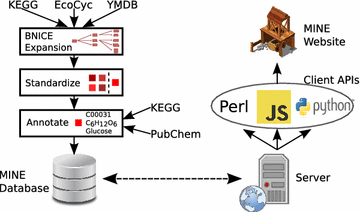
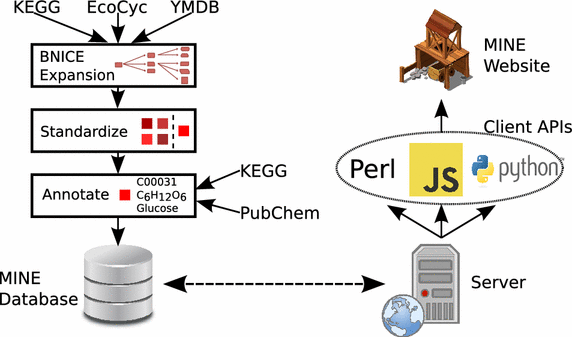
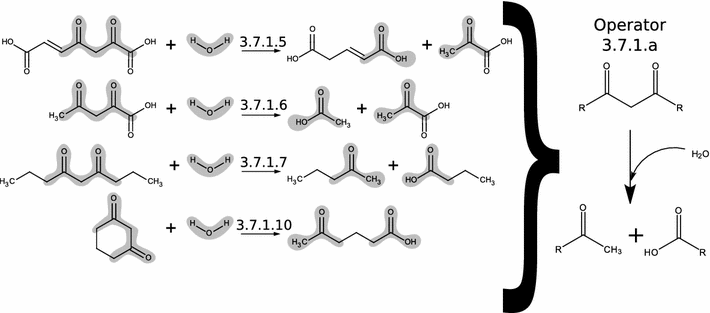
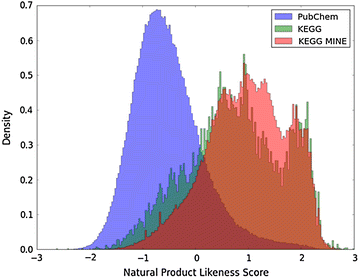
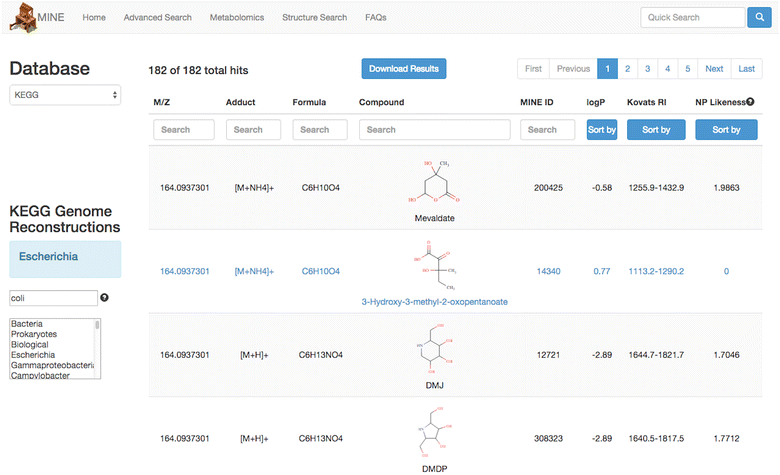
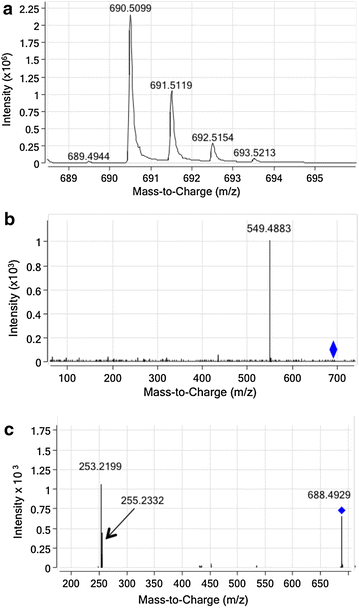
Similar articles
-
[A novel method for efficient screening and annotation of important pathway-associated metabolites based on the modified metabolome and probe molecules].Se Pu. 2022 Sep;40(9):788-796. doi: 10.3724/SP.J.1123.2022.03025. Se Pu. 2022. PMID: 36156625 Free PMC article. Chinese.
-
MINE 2.0: enhanced biochemical coverage for peak identification in untargeted metabolomics.Bioinformatics. 2022 Jun 27;38(13):3484-3487. doi: 10.1093/bioinformatics/btac331. Bioinformatics. 2022. PMID: 35595247 Free PMC article.
-
Pickaxe: a Python library for the prediction of novel metabolic reactions.BMC Bioinformatics. 2023 Mar 22;24(1):106. doi: 10.1186/s12859-023-05149-8. BMC Bioinformatics. 2023. PMID: 36949401 Free PMC article.
-
'Nothing of chemistry disappears in biology': the Top 30 damage-prone endogenous metabolites.Biochem Soc Trans. 2016 Jun 15;44(3):961-71. doi: 10.1042/BST20160073. Biochem Soc Trans. 2016. PMID: 27284066 Review.
-
Software Tools and Approaches for Compound Identification of LC-MS/MS Data in Metabolomics.Metabolites. 2018 May 10;8(2):31. doi: 10.3390/metabo8020031. Metabolites. 2018. PMID: 29748461 Free PMC article. Review.
Cited by
-
ISiCLE: A Quantum Chemistry Pipeline for Establishing in Silico Collision Cross Section Libraries.Anal Chem. 2019 Apr 2;91(7):4346-4356. doi: 10.1021/acs.analchem.8b04567. Epub 2019 Mar 6. Anal Chem. 2019. PMID: 30741529 Free PMC article.
-
Hierarchical Harmonization of Atom-Resolved Metabolic Reactions across Metabolic Databases.Metabolites. 2021 Jun 30;11(7):431. doi: 10.3390/metabo11070431. Metabolites. 2021. PMID: 34209357 Free PMC article.
-
Integrating ion mobility spectrometry into mass spectrometry-based exposome measurements: what can it add and how far can it go?Bioanalysis. 2017 Jan;9(1):81-98. doi: 10.4155/bio-2016-0244. Bioanalysis. 2017. PMID: 27921453 Free PMC article.
-
Epimetabolites: discovering metabolism beyond building and burning.Curr Opin Chem Biol. 2017 Feb;36:70-76. doi: 10.1016/j.cbpa.2017.01.012. Epub 2017 Feb 16. Curr Opin Chem Biol. 2017. PMID: 28213207 Free PMC article. Review.
-
High-throughput Saccharomyces cerevisiae cultivation method for credentialing-based untargeted metabolomics.Anal Bioanal Chem. 2023 Jul;415(17):3415-3434. doi: 10.1007/s00216-023-04724-5. Epub 2023 May 22. Anal Bioanal Chem. 2023. PMID: 37212869 Free PMC article.
References
Grants and funding
LinkOut - more resources
Full Text Sources
Other Literature Sources

